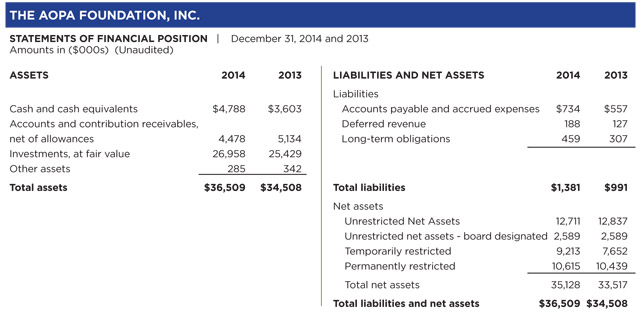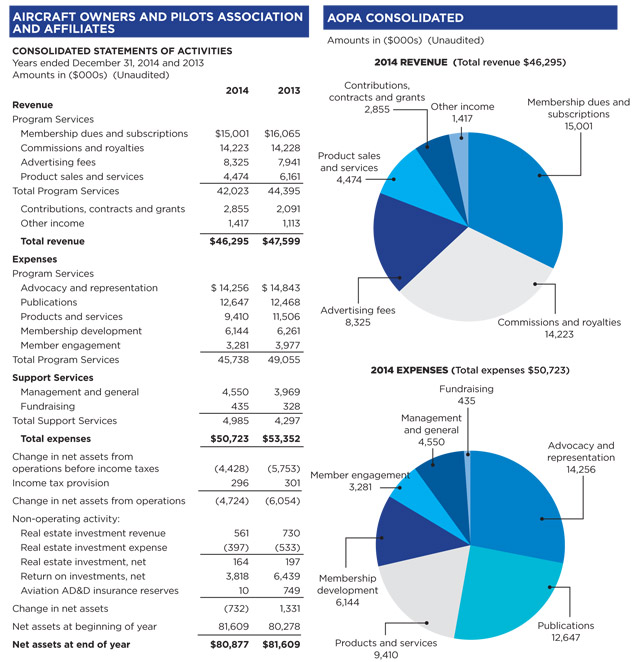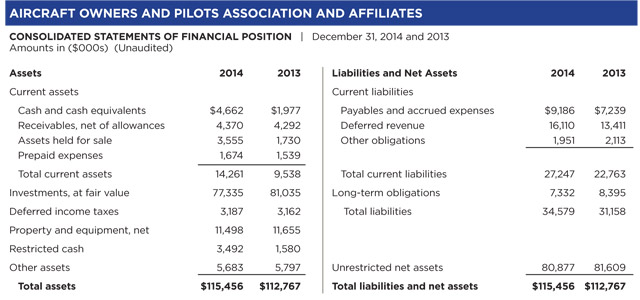Annual Report of the Aircraft Owners and Pilots Association
Taking care of business
We’re working hard for you—and GA

AOPA is a membership organization first and foremost. We’re accountable to you, our members, and that’s why we take this space in the magazine to bring you up to speed on our progress and priorities. Of course, we’re constantly bringing you information about what we’re doing and how we’re doing it, but it can be hard to see all those individual updates in the context of the bigger picture. So I consider this my chance to pull it all together and give you the 10,000-foot view of some of the things we’re doing to serve our members and meet our mission.
I spent a lot of years running businesses, and I know that numbers are important measures of any organization’s health, so we’re including them here. After all, everyone—except maybe the federal government—has to make the books balance. But as much as numbers matter, for an association like AOPA setting the right priorities—and then carrying them out effectively—is at least equally important.
AOPA Foundation
Because of you
Supporting the initiative and programs that help GA
By James Minow, AOPA Foundation Executive Director

With the retirement of Bruce Landsberg at the end of 2014, I was honored to be selected to lead the AOPA Foundation. After 22 successful years with the organization, Bruce’s impact will be felt for a long time to come, and in his final year as president of the foundation, Bruce left the organization on a high note with revenue increases and more AOPA members than ever before donating to support our work to preserve the freedom to fly.
In 2014 the AOPA Foundation provided $4.7 million to support programs that kept pilots safe through the outstanding educational programs of the Air Safety Institute, while also investing in protecting community airports across the country and in programs to expand general aviation and get more people in the air. More than 35,000 members made contributions to AOPA and the AOPA Foundation.
Donations to the AOPA Foundation provided flight-training scholarships to deserving student pilots. Through our Giving Back program, 10 aviation charities received grants to help them provide critical aviation services to those in need. Your contributions helped us launch the popular Rusty Pilots program that reached thousands of dormant pilots, resulting in hundreds of them returning to the cockpit.
Donors to the AOPA Foundation made possible the vast array of Air Safety Institute programs in 2014, include live seminars, online courses, webinars, publications, videos, and quizzes. ASI’s educational offerings are free for anyone, whether or not they are members of AOPA, because our donors’ contributions cover the cost of these valuable programs.
Your donations in 2014 supported our Airport Support Network volunteers, along with AOPA’s regional managers (the faces of AOPA across the country). Both groups worked tirelessly with state and local leaders, aviation communities, and AOPA members to promote the value of general aviation.
In 2014, the AOPA Foundation provided support to launch our new regional fly-ins and the return of the AOPA Homecoming Fly-In. Because of generous donors, pilots and aviation enthusiasts were able to come together at local airports for fly-in days filled with community building, safety training and education, and camaraderie.
The high cost of flying has been a major factor in the decline of GA in America. To bring a reliable, attractive, cost-effective aircraft option to market, AOPA launched a program to test the remanufacturing of Cessna 150s and 152s at very affordable prices for flying clubs and flight schools, all in an effort to make flying accessible to the next generation of pilots. This program was supported in 2014 by an anonymous donation to the AOPA Foundation.
The AOPA Foundation also has underwritten the popular AOPA AV8RS program for teens ages 13 through 18. Donations helped us raise awareness of aviation and aerospace through education, engagement, and support—and provided resources to develop a new generation of pilots, aviation industry leaders, and AOPA members.
As we move into 2015, our mission remains highly focused as we look to help develop aviation STEM programs (watch for more information on this initiative soon). In addition, the board of the AOPA Foundation has approved ongoing funding for the Air Safety Institute, the You Can Fly program, the introduction of “Reimagined Aircraft,” regional fly-ins, and AOPA AV8RS youth program.
Membership dues alone can’t provide the support necessary to carry out the programs that tackle the difficult issues that GA continues to face. In fact, we couldn’t do it without the support of our members who have made the AOPA Foundation their charity of choice.
Email [email protected]

AOPA Air Safety Institute
Serving all pilots
Making—and keeping—safety a priority
By George Perry, Air Safety Institute Senior Vice President
At the Air Safety Institute, general aviation is our passion, our community, and our extended family. We believe that even one GA accident is too many. 2014 was an exciting year for ASI, marked by many significant achievements and a leadership transition designed to help build on past accomplishments. Thanks to donors like you, the Air Safety Institute continues to serve all pilots—not just AOPA members—by providing free safety education programs, research and analysis of safety trends and data, flight instructor refresher clinics, and a nationwide safety outreach program. Pilots rely on ASI to provide them with the tools they need to learn, fly safely, and enjoy the freedom of flight.
ASI’s educational products have contributed greatly to the positive safety trends in general aviation over the past several decades. Most recently, preliminary NTSB data for 2014 suggest a continuation of the favorable trend that began with the all-time low accident record that was set in 2013—which was the first year in U.S. history that the fatal accident rate for GA dropped below 1.0 per 100,000 flight hours (Twenty-third Annual Joseph T. Nall Report). Although the trend is positive, it is our responsibility to provide all pilots of all experience levels engaging educational content that gives them the tools they need to become safer pilots.
Some of our notable accomplishments and contributions to GA safety in 2014 include:
• ASI’s online education, seminars, and CFI renewals used more than 2 million times
• Seminars presented at 200 locations nationwide
• Storm Week and Ice Week webinars
• Twenty-third Annual Nall Report of General Aviation Safety
• New courses, safety videos, and quizzes
• New eFIRC modules allowing CFIs to customize their learning experience
• The Learn & Earn Safety Challenge
• Air Safety Alerts
• Publications such as CFI to CFI and USAIG Safety newsletter
Even though our work is never done—and our measures for success are sometimes difficult to quantify—I’m confident the Air Safety Institute’s mission is important, noble, and our efforts worthwhile. As we move forward, ASI will continue striving for improvement while keeping a weather eye on the horizon. In 2015 pilots can expect to see many of ASI’s most popular courses become iPad compatible; new customizable modules added to our Flight Instructor Refresher course; and, of course, a host of new courses, quizzes, and safety videos. As the future unfolds, ASI will continue to innovate by implementing new ideas, creating world-class content, taking a more proactive approach to safety, and help set the conditions for future success.
On behalf of the entire ASI team, I’d like to express my sincerest gratitude to all AOPA members and also to those of you who have chosen to lend your support for safety with a generous donation. Together, we are making a positive difference and are impacting the lives of pilots and aviation enthusiasts everywhere.
Email [email protected]
AOPA Govenrment Affairs
AOPA’s influence
What it is and why it matters
By Jim Coon, AOPA Senior Vice President of Government Affairs and Advocacy
It is an honor and a privilege to advocate for you in the halls of Congress and in state legislatures all across the nation. Our advocacy team works hard every day for you and our general aviation community. As an AOPA member, you’re part of an organization that has tremendous influence. In fact, when you think about it, the impact we have is astonishing.
When you compare our 350,000 AOPA members to some other advocacy groups that count their members in the millions, we’re small by comparison. And there are dozens of hot-button issues facing Congress every single day—spending and deficits, health care, immigration, national defense, and many more—that would make our general aviation issues all too easy to ignore.
Yet day after day and year after year, literally hundreds of senators and representatives have stepped forward to help protect general aviation. They’ve joined the GA caucuses. They’ve sponsored and supported legislation. They’ve helped us strike down anti-GA regulatory proposals in dozens of federal agencies. Any day of the week, members of Congress are willing to take our calls, sit down with us to discuss our concerns, and help us protect the precious freedoms and privileges we enjoy as aviators.
When our legislative team meets with a member of Congress, he or she knows we are speaking not for ourselves, but for thousands of pilots in their home state or Congressional district. What’s more, members of Congress know that AOPA members like you aren’t just run-of-the-mill voters. They know that many are activists and leaders in their respective communities. But there is another reason why AOPA has such an effective presence in Washington, D.C., and that’s the strength of our AOPA Political Action Committee (PAC).
PAC is a term that’s thrown around a lot, and most of us have only a general idea of what it means. Simply put, PACs are registered with the Federal Election Commission and designed to raise money for congressional candidates.
And PACs are subject to special rules—they can only raise money through voluntary, individual contributions from members of the association. Nonmembers can’t contribute, nor can corporations. And, by law, we can’t use membership dues to support candidates.
For more than four decades, PACs have been a reality of our campaign finance system. PACs give voters a way to pool their resources and make contributions to candidates running for office in the House and Senate.
I can tell you from personal experience that no politician enjoys raising money. But there’s simply no avoiding the fact that the cost of campaigns continues to increase. So, if you’re in Congress, raising money is, unfortunately, a year-round necessity. Through our PAC, we are able to help our supporters defray part of the cost of their next campaign so they can focus on issues, not fundraising. In this way, our PAC helps facilitate the opportunity to educate members of Congress on our issues—issues that otherwise would not get the attention they deserve.
It is these educational efforts that we take on every day that have helped us grow the House and Senate general aviation caucuses into some of the biggest caucuses in Congress. It’s these educational efforts that have helped us win major battles on issues such as sleep apnea testing, CBP stops and searches, GA tower closures, aircraft certification, and more. And it’s these educational efforts that are helping us build momentum for third class medical reform, which is our foremost legislative priority this year.
General aviation issues rarely make the headlines. And the vast majority of American voters couldn’t care less about user fees, avgas taxes, aircraft certification, or medical reform. Yet, every single day, there are elected officials in Washington who are going the extra mile to stand up for pilots like you and me, and who are putting our mission at the forefront of the work they do in Congress. If you’re already one of our thousands of AOPA PAC contributors, thank you for your generous support.
The AOPA Government Affairs team continues to work with the men and women that the American people elect and send to Washington, D.C. We continue to lead for positive change not only for today’s aircraft owners and pilots, but for the future of general aviation in America.
Email [email protected]
For those who want to get started in flying or expand their aviation horizons, we’re creating new ways to pay for training. We recently launched an innovative new flight training financing program that lets you borrow up to $100,000 to pay for primary training, advanced certificates, and even fun add-ons like a seaplane rating or tailwheel endorsement (see page 130).
For those who fly for a living, we’re offering new membership options that address your special needs by providing services such as insurance that covers the loss of your medical certificate, pilot protection services, and flight instructor refresher clinics.
You told us you like to get together, so we’re hosting AOPA Fly-Ins at new locations nationwide—as well as a Homecoming Fly-In at AOPA headquarters in Frederick, Maryland. This year we’ll have new social gatherings, expanded seminar schedules, special product showcases, and even more exhibits and aircraft displays.
There’s a lot going on at AOPA in 2015. We’re expanding on successes—such as Rusty Pilots and the AOPA Fly-Ins—and we’re taking off in new directions with the You Can Fly program, new planning tools, and expanded financing and insurance options. We’ve carefully evaluated each of our activities to be sure it supports our core mission and contributes to getting you flying and keeping you flying. So what are you waiting for? The sky is calling.
Email [email protected]
This year we’re expanding on the success of the Rusty Pilots program we launched last year. As of mid-March, 41 events had been scheduled in 26 states. With more events being added each week, we look forward to getting hundreds more pilots back into active flying status in 2015.
Rusty Pilots is just one element of a more comprehensive program we’ve started this year. We all want to see general aviation grow, and we also know there’s no magic bullet for making that happen. But your association is the place where that needs to start, so we have developed the You Can Fly program and given it a big mission—welcoming newcomers into GA, returning lapsed pilots to the skies, and keeping today’s pilots engaged with flying.
In addition to Rusty Pilots, the You Can Fly umbrella includes outreach to teens, pilot groups, flying clubs, and more. We’ve hired a handful of AOPA Ambassadors to carry the You Can Fly message and test innovative ways to reach more pilots and enthusiasts (see page 38). The goal is to offer a variety of fun, educational, community building, and money-saving opportunities that make it easier for people to start flying and keep flying.
If I had my way, every pilot in America would have access to a flying club—the place where everyone, regardless of income or time, can get into the sky—so this year we’re expanding our commitment to clubs with new kinds of support, from specialized financing and insurance to webinars and newsletters. Flying clubs are great hubs for aviation activity, offer affordable access to aircraft, and provide the kind of support and sense of community—which you told us was an important factor in your enjoyment of flying—that help make flying so much fun. That’s why in 2015 we’re actively building our network of more than 600 clubs and offering improvements to our online Flying Club Finder, which will make it easier than ever to find, start, grow, or connect with a club near you.
And let’s not forget FAA reauthorization. The agency’s long-term funding package runs out at the end of September, and Congress is already taking a hard look at how to structure, and pay for, FAA activities. We’ve already testified before the House Transportation and Infrastructure Committee and taken part in a House Aviation Subcommittee roundtable on the subject of FAA reauthorization, and we will continue to be very active on this issue. The FAA needs a stable source of funding so it can complete long-term projects such as NextGen modernization and research into alternatives to leaded avgas. And we want that money to continue coming from excise taxes, not from user fees. But we also want to see the FAA use its resources wisely, increasing its own efficiency and focusing on the projects that really matter to the safety and effectiveness of our aviation system.
It’s easy to talk about federal advocacy priorities because they affect all of us. But advocacy in the states is also critically important to the way we fly, and it’s a big area of emphasis for 2015 and beyond. This year we’re tracking 530 legislative measures in all 50 states and Puerto Rico. Among the most common issues right now are efforts to lower sales and use taxes on aviation, cut state taxes on aviation fuel, mark meteorological evaluation towers, and add aviation to recreational use statutes as a way to encourage more private landowners to allow aircraft to use their property. Together, these efforts save pilots money and help keep them safe—a big win-win.
Keeping pilots flying also means offering the products and services they need. We’ll be launching two new ways to make your flight planning easier—the AOPA Internet Flight Planner and the AOPA Go mobile flight planning tool. We’re also deep into a massive overhaul effort for AOPA.org that will make the website easier to use and deliver the information, services, and help you want fast.
Getting you flying, keeping you flying
I’d like to start by giving you a sense of my overall vision for AOPA. I’ve already said we’re a membership organization first and foremost. So serving the needs of today’s members is our top priority. But AOPA is also much more than that. Our founders believed in general aviation—its value, utility, and fun—and they set out to protect it and preserve it for the future. I, too, am a believer when it comes to GA and what it can bring to individuals, communities, and our country. So even while we’re always striving to do more for our members today, we’re doing it with an eye to the future. That’s the legacy of our founders, it’s why we’ve been around for more than 75 years, and it’s why we’ll be here to serve pilots for generations to come.
A key theme running through all our efforts, whether we’re talking about advocacy or outreach, is finding ways to get pilots flying and keep them flying. That means working to create a regulatory environment that supports GA, finding ways to make flying more affordable, giving pilots the support they need to fly more often, and getting new people involved in general aviation.
From an advocacy perspective, third class medical reform is our absolute top priority in 2015, and the Pilots Bill of Rights 2 (PBR2) looks like the vehicle that can get us there. It would allow pilots to make recreational VFR and IFR flights in aircraft up to 6,000 pounds without the need for a third class medical certificate. And it provides additional protections, particularly for pilots facing an enforcement action.
I know many of you are in a hurry to see this done and are frustrated by the slow pace of progress. No one is more frustrated than I am. But we’ve got strong support for this legislation in Congress and in the aviation community, and I feel confident we can get reform this year. In just the first couple of weeks after the legislation was introduced, more than 32,000 AOPA members contacted their lawmakers and asked them to sign on as co-sponsors—and more than 30 elected officials in the House and Senate did just that.
Lowering the cost of ADS-B Out compliance is another top priority. We don’t want to see general aviation pilots shut out of airspace, so we need pathways to equip for ADS-B Out ahead of the 2020 mandate. We’re working closely with the FAA, other aviation groups, and avionics manufacturers to come up with solutions that make sense, and we’re seeing real progress. Already this year, some technical issues have been addressed and we’ve seen new products that could cut the cost to equip in half.

Listening and learning
When I came to AOPA, my top priority was what I called “seeking to understand,” and I spent a good deal of time traveling around—meeting as many members as possible, and listening to your thoughts about what matters most. During the course of 2014, all of us at AOPA worked to develop a deeper understanding of what’s important to you as pilots and aircraft owners. We also put a lot of effort into finding out what you want and expect from us as your aviation association. Then we took what we had learned and began the process of turning it into real, actionable programs that could make a difference—for you as pilots, and for the future of general aviation.
If 2014 was all about learning and planning, then 2015 is all about executing on those plans and bringing our ideas to life. But before I get into how we’re doing that, I’d like to take a quick look back on just a few of the important issues that shaped 2014.
As I traveled around listening to our members, you consistently made it clear that you depend on AOPA to advocate for you. After all, while individuals can play an important role in advocacy, it usually takes many voices speaking together (and sometimes loudly) to get the attention of Congress or big government bureaucracies such as the FAA—and that’s where an organization like AOPA makes all the difference. So in 2014 we put our advocacy team to work on the biggest issues affecting your flying, and we got some great results.
We brought an end to the unwarranted stops and searches of GA aircraft by Customs and Border Protection and the agency has since made changes in how it handles training, communication with the GA community, and the use of local law enforcement agencies. We also put a halt to a new sleep apnea policy that would have forced tens of thousands of pilots to undergo expensive and intrusive medical tests strictly because of their body mass index (BMI).
And AOPA played a big part in getting changes to the pilot certification process, some of which took effect earlier this year. By getting rid of outdated questions on knowledge tests and more closely integrating the knowledge and practical exams, we can help make sure pilots have the tools and training they need to make good decisions and fly safely.
Also in 2014, we found new ways to connect to our members, starting with the inaugural AOPA Fly-Ins celebrating our seventy-fifth anniversary. During these events, we met more than 16,000 members and aviation enthusiasts, parked almost 3,000 airplanes, and had the help of nearly 1,700 volunteers.
We connected with our members in more traditional ways as well. The experts in our Pilot Information Center provided direct technical assistance approximately 140,000 times in 2014, and our member services team responded to more than 123,000 phone calls and Emails.
We learned that many pilots held certificates but had stopped flying—even though they still shared a passion for aviation—so we launched the Rusty Pilots program to get lapsed pilots back in the air. During the program’s first year, more than 2,600 people participated in 68 seminars, and 18 percent of those have told us they’ve since completed a flight review and returned to active flying status.
Then there are the thousands of pages of new printed and online content produced in 2014 and delivered to members through AOPA Pilot and Flight Training magazines, the ePilot and Aviation eBrief newsletters, and our websites. And don’t forget the top-quality videos produced for AOPA Live and the webinars on specialized topics, from medical and insurance issues to launching and growing flying clubs.
Of course, these are just a very few highlights of what we accomplished in 2014. It was a successful year by any measure, but that’s runway behind us. So let’s talk about 2015 and beyond.


Top Advocacy Wins in 2014
• No more CBP stops and searches
• Stopped BMI-based sleep apnea policy
• Updated pilot certification and testing
• New and expanded state tax cuts
• Strong support for third class medical reform
• Drew attention to problems with ADS-B implementation
• Significant progress in search for avgas alternatives

Top National Advocacy Issues for 2015
• Third class medical reform
• Lowering the cost of ADS-B Out
• FAA reauthorization

Top State Advocacy Activities in 2015
• 530 bills in 50 states and Puerto Rico
• Cuts to sales and use taxes
• Cuts to fuel taxes
• Marking meteorological evaluation towers
• Limiting liability for aviation use of private property

You Can Fly
• New AOPA Ambassadors deliver the message
• Reimagined aircraft demonstrate flying can be fun and affordable
• Rusty Pilots gets lapsed pilots current
• Flying Club Network gives more people access to affordable ownership
• Teen outreach efforts include AV8RS membership and partnership with Boy Scouts of America

Top Outreach Efforts in 2014
• More than 16,000 participants at AOPA Fly-Ins
• More than 35,000 visitors to AOPA tents at major airshows
• More than 2,600 Rusty Pilots participants


